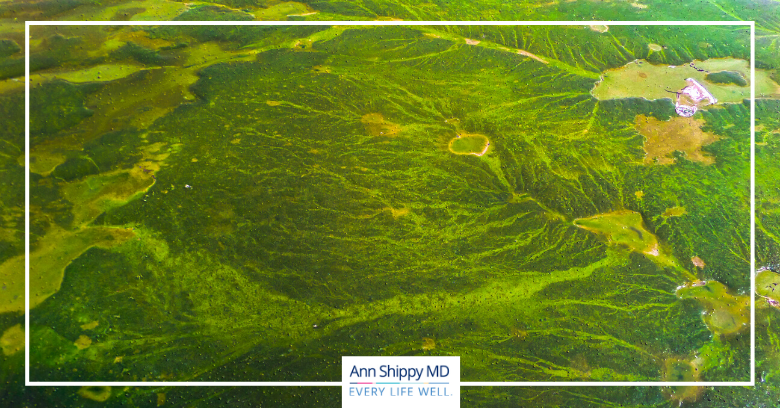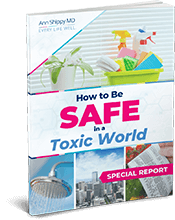In 2017-2018 a landmark red tide event occurred in Florida that affected over a hundred miles of coastline and lasted for over a year causing deaths to sea life and affecting human health. I followed this story closely, and it made me consider this source of environmental toxins when uncovering the root causes of symptoms and disease for my patients.
Since that time, I’ve been hearing of more areas where water has become contaminated. Now, not a week goes by where I don’t see a news story about algal blooms, the causes and consequences.
Harmful Algal Blooms, or HABs, are becoming a huge environmental and public health issue, affecting communities in all 50 states and globally.
Most of us generally understand water contamination is not a good thing, and we probably know that we should not swim in affected water. But most people don’t realize that even breathing the air nearby a Harmful Algal Bloom can cause serious health problems. Researchers speculate that airborne exposure to a toxin found in blue-green algae, BMAA, could lead to neurological ailments even 20 or more years after exposure.
In this post, I want to update you from my previous article on the topic and cover:
- What is a Harmful Algal Bloom?
- What causes algal blooms?
- Algal bloom effects
- What you can do
What Is a Harmful Algal Bloom?
An algal bloom is simply an overgrowth of algae in a waterway. A Harmful Algal Bloom, or HAB for short, is when the algae produce toxins that are harmful to the ecosystem, animals and human health. HABs can occur in salt water or freshwater and examples include red tides, blue-green algae and cyanobacteria.
Red tides, like the one I mentioned in Florida, are caused by Karenia brevis algae that release a neurotoxin called brevetoxin. The HAB species famous for the large algal blooms in Lake Erie is Mycrocystis. Since a picture is worth a thousand words, here is an image from the National Oceanic and Atmospheric Administration, NOAA, of Lake Erie.
“While most of us generally understand water contamination and probably know that we should not swim in affected water, people don’t realize that even breathing the air nearby a Harmful Algal Bloom can cause serious health problems.”
With algal blooms in general and HABs specifically, you’ll notice foam or scum on the water along with red, blue, green or brown colors. HABs create dead zones in the water, and they are harmful to human health. As you can imagine, water clean-up is extremely costly.
HABs are naturally occurring and have been documented since the 1500s. While algae at low levels are relatively harmless, it is when it blooms that it becomes an issue. Now we have a more serious problem, because the rates of blooms are certainly rising and lasting longer than they once did.
The good news is that scientists recognize this problem and are learning more about these blooms than ever before in order to detect them, warn the public and of course mitigate the effects for humans and the environment. NOAA offers HAB forecasts for certain areas of concern including both the Gulf Coast and Lake Erie. If you are curious about your local water issues, you can check reporting in your area, and I definitely encourage you to!
What Causes Algal Blooms?
For algae to bloom it needs three things:
- Sunlight
- Slow moving or stagnant water
- And… nutrients like nitrogen and phosphorus
High levels of nitrogen and phosphorus in water is termed nutrient pollution and comes from manure and chemical fertilizers from agriculture, storm water, waste water, fossil fuels and even fertilizers and pet waste from homes.
Rises in temperatures, changes in precipitation and increased runoff from industrial agriculture are all reasons for more and longer lasting HABs. Some say that HABs might be yet another consequence of climate change. Certain algae prefer warmer water and large storms, and following droughts, can increase the runoff into waterways providing the nutrients that the algae needs to bloom.
Algal Bloom Effects
The bottom line is that algal blooms are not good for ecology or for health. Algal toxins are a threat to water quality and can contaminate drinking water, recreational water, air and food.
HABs are toxic to humans, plants and animals. In the ocean, red tides can kill fish, turtles, dolphins, seaweed and other marine life. In lakes and ponds, everything from insects to frogs and of course fish can be impacted.
For humans, the toxins become airborne and both breathing contaminated air and being exposed to water or contaminated seafood can cause a host of symptoms, including:
- Headaches
- Digestive symptoms including diarrhea, abdominal pain, nausea and vomiting
- Fever
- Skin reactions including irritation and rashes
- Neurological symptoms
- Asthma-like symptoms or exacerbation of respiratory illness
- Red itchy eyes
- Coughing, wheezing, sneezing
- “Brain fog”
If you have been exposed to algal blooms and are experiencing any of these symptoms, it is important to seek immediate medical help. Children are especially at risk of experiencing effects from toxin exposure because of their smaller size and phase of development. Pets are also more easily affected.
The documentary, Toxic Puzzle, explores algal blooms around the world and suggests that HABs can be a trigger for ALS, Alzheimer’s and Parkinson’s disease since people with these diseases tend to cluster near algal blooms. To date this has not been supported in the peer-reviewed research, but it has not yet been extensively studied. However, from a Functional Medicine perspective, often someone has a genetic predisposition for a disease, and then a toxic exposure can trigger the disease process. In other words, genetics load the gun, but the environment pulls the trigger. I now consider HABs as a possible toxic trigger, just as I do mold or mercury.
What Can You Do About HABs?
Since algal blooms are a growing problem and beginning to affect more and more susceptible people and communities, what can you do? The first step is awareness. Before the red tides in Florida a few years ago, this topic was not much on my radar, but now I follow much more closely.
“Often someone has a genetic predisposition for a disease, and then a toxic exposure can trigger the disease process. In other words, genetics load the gun, but the environment pulls the trigger. I now consider Harmful Algal Blooms as a possible toxic trigger, just as I do mold or mercury.”
Politically, we can all support legislation to protect waterways and reduce use of harmful chemicals. For so many reasons, having access to clean water now and in the future is critical. You can also take action by writing your local leaders. Go here to have your voice heard.
In your personal environment, you can prevent nutrient and chemical pollution from your yard or home and ask your neighbors to do the same.
Wellness Tips
To protect your body from the harmful toxins produced by algal blooms:
- Stay out of and away from HAB contaminated water. Make sure your pets stay away too.
- Do not eat fish and seafood from affected coastlines or lakes.
- Follow warnings and guidelines for drinking water in your community, and purify your water at home with a filtration system.
When it comes to toxins, we can avoid what we know about, but because of the sheer abundance of chemicals in the environment, we are unable to control all personal exposures. For that reason, I recommend using Functional Medicine approaches to strengthen your body’s ability to detoxify and handle an exposure should you not be able to avoid it.
Wellness Tips to Strengthen Detoxification:
- Heal your gut. If the gut is inflamed, infected or leaky, toxins are more likely to enter into the body via the digestive system and cause an immune response in the body. So, Step One is to heal your gut. Leaky gut, or intestinal permeability, is where the tight junctions between the cells of the small intestine become loose and larger proteins from food, bacteria or toxins are able to get into the body, instead of entering fully digested or passing through the GI.
In my clinic, I use the 5 R protocol to heal the gut:
- Remove: Remove any foods that you are sensitive to, along with any bacteria, yeast or parasites that are pathogenic or out of balance. The Paleo diet is the best place to start for reducing inflammation and uncovering food sensitivities in the gut.
- Replace: Replace any digestive secretions that are low, such as hydrochloric acid or digestive enzymes.
- Re–inoculate: Build up health communities of beneficial bacteria by using fermented and fiber-rich foods along with probiotic and prebiotic supplements.
- Repair: Repair and heal the lining of the digestive system with soothing herbs and specific nutrients such as glutamine, zinc and omega-3 fats. 5
- Rebalance: Keep the GI tract healthy and happy by prioritizing sleep, stress management and movement.
- Support your detoxification systems. Your body removes toxins through the lungs, liver, kidneys, large intestine and skin. You can support your detoxification systems daily through breathing and meditation, eating well, sleeping, staying hydrated, having regular bowel movements and sweating with exercise or saunas. In addition, certain supplements can be helpful based on your needs. If you’ve been exposed to HABs, you might consider using a toxin binder like Toxin Clear and liposomal glutathione.
- Reduce your toxin load. This means getting rid of all the toxins that you can control in your environment by choosing non-toxic personal care products, safe cleaning products and investing in good water and air filters. Here are 10 Toxins to Easily Avoid and my free report on #EverydayToxicity for more information.
- Support methylation. Methylation is one of the most important processes in the body and is essential for detoxification. Many of us have genetic variations, or SNPs, that can lead to slower detoxification. Your personal methylation status is great information to know for yourself and a frequent test I order for patients in my office. If you discover that you are not optimally methylating, you can support your body’s methylation process by avoiding synthetic folic acid, increasing certain nutrients such as B vitamins and prioritizing other lifestyle interventions. (See our Methylation Support supplement here.)
“If the gut is inflamed, infected or leaky, toxins are more likely to enter into the body via the digestive system and cause an immune response in the body. So, Step One is to heal your gut.”
Since Harmful Algal Blooms are increasing in number and severity and occur in all 50 states, this is an important environmental topic to be aware of. HABs can be devastating to the environment, human health and even to the economy of affected areas. Much can be done on larger scales to prevent and reduce algal blooms, yet again it all begins with awareness.
On the personal level and for protecting the health of yourself and your family, it comes back to many foundations of Functional Medicine: eating well, sleeping well, living a low-stress and low-toxin lifestyle along with addressing personal root causes to optimize your health. This approach provides the most solid foundation to health and resiliency throughout your life. And I’m here to support you on this journey!













